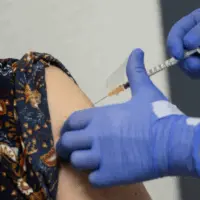
(NEW YORK) — With coronavirus infection rates back on the rise, many Americans are wondering why the U.S. is, once again, experiencing surge in cases and hospitalizations, despite widespread vaccinations.
The U.S. is now reporting more than 94,000 new COVID-19 cases each day — up by 47% since late October. And 35 states — nearly all of them in the north or mountain region — have seen an uptick in daily cases of 10% or more in the last two weeks.
Just under 53,000 COVID-19 positive patients are currently receiving care in hospitals across the country — up by more than 7,000 patients from earlier this month.
Several states — including Michigan, Maine and New Hampshire — are experiencing record-breaking surges.
Experts say a confluence of factors is likely driving the country’s recent increases in infections, including the more than 100 million Americans who remain completely unvaccinated, cold weather and relaxed restrictions, the highly transmissible delta variant, and waning vaccine immunity.
Unvaccinated Americans continue to drive COVID-19 transmission
According to health officials, the vast majority of infections and severe hospitalizations continue to be among the unvaccinated.
This September, federal data showed that unvaccinated individuals have a 5.8 times greater risk of testing positive for COVID-19, and a 14 times greater risk of dying from it, as compared to those fully vaccinated.
“The thing we are concerned about is the people who are not vaccinated, because what they’re doing is they’re the major source of the dynamics of the infection in the community,” Dr. Anthony Fauci, the White House’s chief medical adviser, said during an appearance on ABC’s “This Week” on Sunday. “The higher the level of dynamics of infection, the more everyone is at risk.”
Across the country, more than 101 million Americans remain completely unvaccinated — 81 million of whom are currently over the age of 5, and thus are eligible to be vaccinated.
The significant number of unvaccinated individuals — about 30.5% of the total population — leaves millions at-risk and completely unprotected against the virus.
Relaxed restrictions, increased travel, and colder weather pushing people indoors
With winter arriving, and the holiday season on the horizon, many Americans are spending more time indoors, as the weather gets colder. COVID-19, as well as other respiratory illnesses, has been shown to spread more in indoor settings, and when people are forced to be in close proximity to one another.
Millions of Americans are also once again traveling, taking to the air, the railways and the highways. A total of 53.4 million people are expected to travel for Thanksgiving, up 13% from 2020, according to estimates from AAA.
Although masking is required in all forms of public transportation, across the country, COVID-19 restrictions are sparse, with few jurisdictions now requiring face coverings or social distancing.
“We’re seeing cases trickle up, this is probably likely due to waning immunity, but also because of the colder temperatures people are gathering indoors and adhering less to social distancing and masking,” John Brownstein, an epidemiologist at Boston Children’s Hospital and an ABC News contributor, told “World News Tonight.” “Unfortunately, that is a recipe for an increase in transmission this holiday season.”
Masking has been shown to reduce the risk of COVID-19 transmission, and is still recommended by the Centers for Disease Control and Prevention in crowded outdoor settings and for activities with close contact with others who are not fully vaccinated.
Delta variant remains highly transmissible
In the U.S., federal data shows that the delta variant accounts for 99.9% of new coronavirus cases. According to the CDC, delta is far more transmissible than prior variants.
Many of the country’s northern states were not as hard hit by the delta surge over the summer. Those states are just now feeling the impacts of the delta variant. Comparatively, states like Florida, which bore the brunt of the summer delta surge, are reporting very low COVID-19 infection numbers.
“We’re seeing is pockets of surges across this country, the Midwest being one but also in the Northeast,” Brownstein said
The delta variant spreads more easily among vaccinated people than prior versions of the virus, though vaccinated people are still far less likely to spread the virus compared to unvaccinated people.
Vaccine immunity is waning
Although the vast majority of infections and severe hospitalizations are among the unvaccinated, breakthrough positive COVID-19 cases among the vaccinated do appear to be on the rise, due to waning immunity, according to health officials.
“There’s no doubt that immunity wanes. It wanes in everyone. It’s more dangerous in the elderly, but it’s across all age groups,” Fauci said earlier this month, citing data from Israel and the U.K., where more people were vaccinated sooner and began to first document waning immunity.
Experts stress that the vaccines remain highly effective against severe COVID-19 illness.
Boosters are now recommended for everyone 18 and older, at least six months after an initial Pfizer or Moderna vaccination, or two months after a Johnson & Johnson shot.
Copyright © 2021, ABC Audio. All rights reserved.














